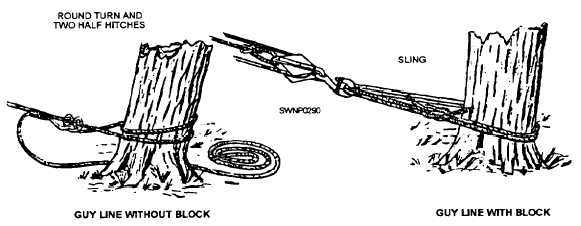should be 1 7/8 inches (51.2 mm) in circumference. Lifelines and safety belts must be used when working on unguarded scaffolds at heights of 10 feet (3 m) and above (as well as on boatswain's chairs, as explained earlier). If working over water, life jackets must be worn.
All scaffolds and scaffold equipment should be maintained in safe condition. Avoid making repairs or alterations to a scaffold or scaffold equipment while in use. Rather than take a chance, NEVER permit personnel to use damaged or weakened scaffolds!
FIELD-ERECTED HOISTING DEVICES
Because of the nature of heavy construction, Steel workers must at times erect heavy structural members when constructing pre-engineered buildings, piers, bridges, and many other components related to Advanced Base Functional Components (ABFC). These members are usually hoisted into position using cranes, forklifts, or other construction equipment. In contingency/ combat operations, however, because of operational commitments this equipment may not be available and structural members must be hoisted without the use of heavy equipment. We will now discuss some of the methods which can be used for the erection process when heavy equipment is not available.
The term
field-erected hoisting device refers to a device that is constructed in the field, using material available locally, for the purpose of hoisting and moving heavy loads. Basically, it consists of a block-and-tackle system arranged on a skeleton structure consisting of wooden poles or steel beams. The tackle system requires some form of machine power or work force to do the actual hoisting. The three types of field-erected hoisting devices used are gin poles, tripods, and shears. The skeleton structure of these devices are anchored to holdfasts.
HOLDFASTS
Gin poles, shear legs, and other rigging devices are held in place by means of guy lines anchored to holdfasts. In fieldwork, the most desirable and economical types of holdfasts are natural objects, such as trees, stumps, and rocks. When natural holdfasts of suffient strength are not available, proper anchorage can be provided through the use of man-made holdfasts. These include single picket holdfasts, combination picket holdfasts, combination log picket holdfasts, log deadmen, and steel picket holdfasts.
Natural Types of Holdfasts
When using trees, stumps, or boulders as holdfasts, you should always attach the guys near ground level. The strength of the tree, stump, or boulder size is also an important factor in determining its suit ability as a holdfast. With this thought in mind, NEVER use a dead tree or a rotten stump or loose boulders and rocks. Such holdfasts are unsafe because they are likely to snap or slip suddenly when a strain is placed on the guy, Make it a practice to lash the first tree or stump to a second one (fig. 6-43). This will provide added support for the guy.
Rock holdfasts are made by inserting pipes, crowbars, or steel pickets in holes drilled in solid rock. Using a star drill, drill holes in the rock 1 1/2 to 3 feet apart, keeping them in line with the guy. Remember to drill the holes at a slight angle so the pickets lean away

Figure 6-43. - Using trees as a holdfast.
Continue Reading